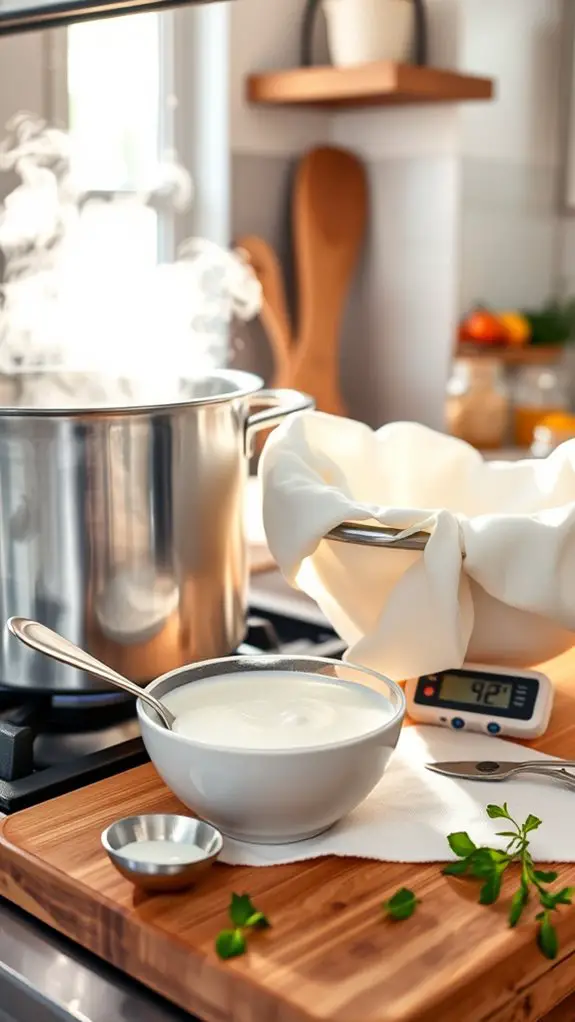You've been eyeing that pricey Greek yogurt at the grocery store, haven't you? Imagine crafting your own creamy, protein-packed version right at home. It's simpler than you think and the gut-healthy benefits are unbeatable. All it takes is a few easy steps – and you'll be whipping up batches that'll have your taste buds doing cartwheels. Ready to ditch the store-bought stuff and plunge into homemade bliss?
History

Although yogurt has been around for centuries, the production of Greek yogurt can be traced back to ancient Greece. The ancient Greeks utilized traditional fermentation techniques to create a thick, creamy, protein-rich yogurt.
This ancient process involved culturing milk with live active cultures, which transformed lactose into lactic acid. The result was a nutrient-dense, gut-healthy yogurt with a distinctive tangy flavor.
Over time, this ancient Greek technique evolved, leading to the modern production of Greek yogurt enjoyed worldwide today. The rich history and traditional methods underlying Greek yogurt contribute to its exceptional nutritional profile and delightful taste.
Recipe

Making homemade Greek yogurt is a rewarding and cost-effective way to enjoy a healthier and more versatile yogurt. The process is relatively straightforward, allowing you to customize the tartness, thickness, and flavor to your preference.
Unlike traditional yogurt, Greek yogurt undergoes a straining process that removes the whey, resulting in a creamy, protein-rich, and low-carb yogurt. This recipe will guide you through the steps to create your own delicious homemade Greek yogurt.
Ingredients:
- 1 gallon of whole milk
- 2 tablespoons of plain yogurt with active cultures
Cooking Instructions:
Heat the milk in a large pot over medium heat, stirring occasionally, until it reaches 180°F.
Remove the pot from the heat and let the milk cool to 110°F. Once the milk has cooled, stir in the 2 tablespoons of plain yogurt with active cultures.
Cover the pot and let the mixture sit undisturbed for 8-12 hours, or until the yogurt has thickened to your desired consistency.
After the yogurt has set, line a colander with cheesecloth or a clean kitchen towel and pour the yogurt into the colander.
Allow the yogurt to strain for 2-4 hours, depending on how thick you want the final product. Discard the whey that collects in the bowl.
Transfer the strained Greek yogurt to an airtight container and refrigerate for up to 2 weeks.
Nutritional Guide
Homemade Greek yogurt offers a nutritional powerhouse.
It's laden with protein, which supports muscle growth and repair. Plus, its probiotic content nourishes your gut, promoting healthy digestion and a robust immune system.
The live cultures in Greek yogurt also produce beneficial compounds that may reduce inflammation and cholesterol levels. Its calcium and vitamin B12 content further contribute to bone health and energy production.
Compared to regular yogurt, Greek yogurt packs nearly twice the protein and fewer carbs, making it an ideal choice for weight management.
Indulge in this tangy, creamy treat and reap the abundant health benefits it provides.
Final Thought
Given the abundant health benefits of homemade Greek yogurt, you'd be remiss not to incorporate this nutrient-dense, protein-rich, gut-healthy delight into your diet.
Its high-quality protein and probiotics promote muscle maintenance, digestion, and immune function. Enjoy Greek yogurt as a satisfying breakfast with fresh fruit, or use it to create creamy, protein-packed dips and dressings.
Whether savoring it solo or incorporating it into your favorite recipes, homemade Greek yogurt's versatility and nourishing properties make it an excellent addition to your lifestyle.
Reap the rewards of this wholesome, probiotic-packed superfood and experience the transformative impact on your overall well-being.